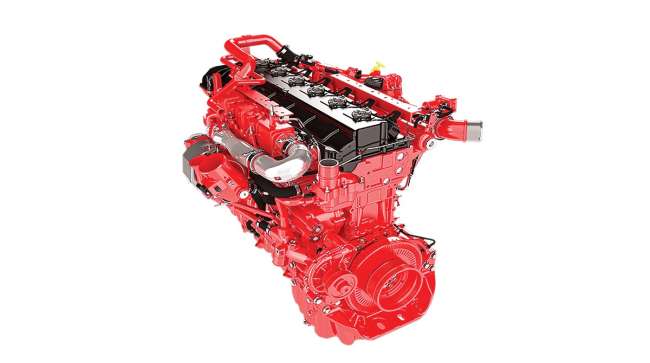Natural Gas Truck Engines Could Reduce Fuel, Maintenance

[Find the latest in equipment & maintenance: Explore this quarter's issue of Calibrate]
A driver heads for his cab, jumps in, belts up and hits the starter button. It’s only 10 degrees outside, but the engine fires almost immediately, and runs quietly while he warms it up. No fuel heaters are in use. Nobody has added any anti-gel to the fuel tank. As the day wears on, he drives peacefully, believing that the chance of getting any engine codes relating to the emission systems on his tractor are unusually low.
The same morning at the fleet’s accounting office, the staff looks over its fuel cost records, noting a measurable reduction in fuel costs although no large changes have occurred in where they run — just the purchase of a few new tractors.
Welcome to the not-so-messy middle. Changes such as these are likely to come to fleets that begin specifying natural gas-fueled tractors.
By the middle of next year, Cummins will be offering a full-size truck engine that runs on natural gas called the X15N. Cummins Inc. has been a pioneer in providing spark-ignited natural gas engines for trucks beginning with the ISX12N engine, originally modified by Westport Fuel Systems to run on natural gas. Cummins and Westport established a joint venture that provided the system for Cummins engines, and the engine manufacturer now owns that venture and its patents.

More Q3 Calibrate
►Fleets Tackle Parts Shop Organization
►Freeze: Step Up Push to Bring Veterans Into Trucking
►Trucking Industry Works to Make Electric CVs More Affordable
►Baxter: Natural Gas Engines Could Reduce Fuel, Maintenance
►TMC Corner: Summer Conference Places Priority on Education
Explore the Issue!
“This is the first engine on the next-generation X15 fuel-agnostic platform. Diesel and hydrogen will follow later,” said David King, Cummins’ North American on-highway product manager, natural and renewable gas engines. He explained that the new platform provides internal parts that are common below the head gasket. “The natural gas engine will have a unique cylinder head for the necessary cooling, a spark ignition system, etc.” The new engine has advanced, leaned-out architecture, he added.
The X15N engine is a technological tour de force that combines some of the best of today’s truck diesel technology with user-friendly combustion and emissions technology similar to what is seen in the gasoline engine used in passenger cars. While Westport has an interesting natural gas system called HPDI (high-pressure direct injection) that works more like a diesel, Cummins has adopted a system that, according to King, “is spark ignited with an inductive ignition system,” which means ordinary spark coils and spark plugs like cars have — and a far simpler aftertreatment system than we see on diesels.
“Fuel will be injected at a single point after the intake throttle through the use of a multi-solenoid metered fuel manifold system,” he said.
Like in an automotive fuel injection system, the engine’s ECM will calculate the volume of fuel needed to match airflow through sensor inputs that measure factors like the throttle position, engine RPM and turbo boost pressure. The system is actually simpler than modern automotive fuel injection because gas is a vapor, thus mixing with perfect uniformity with intake air when introduced at a single point.
Unlike the HPDI system or a diesel, this system relies largely on the extremely high knock resistance (octane) of natural gas to allow a high enough compression factor for efficiency and power. Gas’s natural resistance to knock is augmented via the use of jacket-water cooled EGR, allowing the engine’s power, torque and efficiency to be maxed out the way diesel power is — with turbocharging and charge-air cooling, so much of the basic architecture of the engine will be familiar. Because the engine will have a lower compression ratio than a diesel (at 12:1), it will be slightly less efficient. However, it’s obvious some serious advanced engineering went into getting the same 1,850 pound-feet of peak torque from this engine as we see in the highest-rated X15 Efficiency Series diesel.
Why this system rather than the HPDI system, which will get closer to diesel efficiency?

Baxter
Mainly because of the engine’s vastly simpler aftertreatment system — one King describes as “a passive three-way catalyst system, no DEF injector or regenerations needed. There are temperature sensors and oxygen sensors to monitor the performance of the aftertreatment system.” And no DPF cleaning, either. The potential savings in aftertreatment maintenance costs is the big reason Cummins chose a spark-ignited system where, unlike in a diesel, the engine ingests only the exact amount of air needed to completely combust the fuel. The result is the ability to kill NOx in that maintenance-free three-way catalyst. The fact that the fuel and air are completely mixed well before combustion is what makes this possible.
And, as far as fuel cost goes, in spite of the engine’s slightly lower thermodynamic efficiency, King says, “Natural gas has traditionally been far less volatile and much more predictable in price than diesel, and with CNG (compressed natural gas) and LNG (liquefied natural gas) credits, this differential can be greater, enabling a faster return on investment while at the same time reducing a fleet’s carbon footprint.” In other words, both fuel cost savings and a chance to burnish the fleet’s public image.
King noted that CNG could give a 13%-17% greenhouse gas emissions reduction. Natural gas, mostly methane, has exactly half the carbon of diesel fuel, but the fact that the engine is slightly less efficient than a diesel combined with the energy needed to compress it for storage on the vehicle drops the GHG savings a bit.
But, “If you use renewable natural gas, it’s a whole different ballgame,” he adds. “Depending on feedstocks, RNG can provide a significant well-to-wheel carbon intensity reduction and can even be significantly negative.”
Another benefit is that, “NOx and particulate matter (PM) are 90% below today’s diesel requirements,” a fact that can be communicated to help a fleet’s image, especially where their trucks run through urban areas.
King explained that the driver will be treated to the familiar powerful feel of a diesel.

King
“The X15N will have torque curves very similar to the X15 diesel, including the low-end peak torque. The engine will be available with the Eaton Cummins Endurant HD-N 12-speed automated transmission as well as the Allison 4000 Series of transmissions,” he said.
The torque curve for the X15N’s 500 hp, 1,850 pound-feet rating is very close to that of the X15 diesel — putting out about 1,800 pound-feet at 1,000 RPM and getting to the peak rating by 1,100 RPM, quite a feat of engineering with this type of combustion system.
“The X15N is significantly lower in noise at both idle and in driving conditions, providing benefit to the vehicle operator as well as the community. And overall, refueling natural gas vehicles is simple and clean for the driver,” King added. “Natural gas can provide fast refueling like a diesel to fit into a fleet’s normal operation such as slip-seating or multishift operation. Some fleets install overnight fill (or ‘slow fill’) for operations where the vehicle is not in operation at night, for an application such as refuse.”
But, what about fuel availability?
Vehicles with this engine may not be able to do cross-country runs just yet. But fueling infrastructure is growing for commercial vehicle CNG, said King. “The fuel providers are investing to build out dedicated CNG stations as well as adding CNG to conventional fuel locations. Cummins is providing fuel storage and delivery system and support as well,” he added.
What should maintenance managers expect?
“Maintenance for natural gas engines is more similar to diesel than other alternative technologies” King said. “The biggest difference is, of course, the ignition system and spark plug changes. With the X15N, we are working toward longer maintenance intervals than the ISX12N to be closer to diesel-like. Air filter changes will be similar to diesel as will coolant change intervals. We are also working to align oil drain intervals and spark plug changes to minimize maintenance downtime.”
Want more news? Listen to today's daily briefing above or go here for more info
Oil specifications are different because of the fact that the blow-by has high moisture content. King says, “Cummins Oil Spec CES 20092 covers the needs for X15N. It is key that the oil meets this specification. There are oils that meet both diesel and natural gas requirements. An example is the Valvoline One Solution. Using oils like this is best way to fail-safe mixed fleet maintenance.”
King concludes, “Channel readiness is key for a successful launch of the X15N. Cummins is working with its own sales and service locations as well as the dealer network to be ready to support the product launch, which includes the training and certification of technicians, parts stocking and sales training. There are facility requirements for servicing fueled natural gas vehicles inside, and we are working with the channel to ensure that these requirements are understood and that the channel is prepared.”
King noted that fleets should expect availability to start in early to mid-2024.




